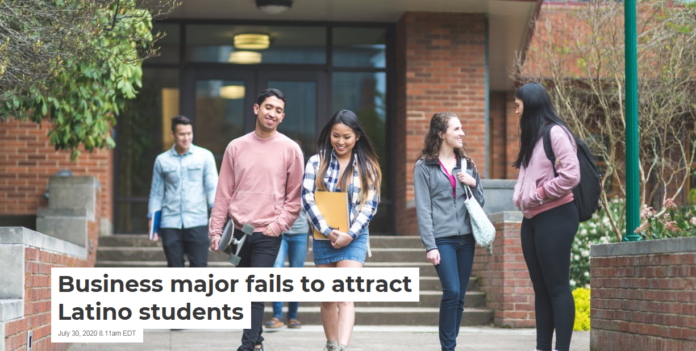

Kevin Singer, North Carolina State University; Alyssa N. Rockenbach, North Carolina State University; Laura S. Dahl, North Dakota State University, and Matthew J. Mayhew, The Ohio State University
The COVID-19 pandemic exposed the inequity of the U.S. economy toward minority racial and ethnic groups. Research shows that successful entrepreneurship can help reduce the racial wealth disparity, especially for the Latino community.
For example, Latino business owners are more likely to hire people within their communities. This results in helping lower unemployment among Latinos and increasing the purchasing power of Latino neighborhoods.
Latinos make up approximately 18.5% of the American population, but account for just 4% of executive or senior-level managers, and 9% of first-and mid-level managers.
They are also underrepresented at America’s business schools, representing only 12.6% of business degrees awarded at the bachelor’s level and 5.8% of those who took the GMAT in 2018, which is a test used for admission to graduate business school programs.
Not a popular major
Business schools aren’t successfully attracting Latino college students after they’ve started college. That’s according to recent findings from the Interfaith Diversity Experiences and Attitudes Longitudinal Survey, or IDEALS.
The study – done in partnership with the Interfaith Youth Core, North Carolina State University and Ohio State University – followed thousands of students from over 120 colleges and universities through four years of college, from 2015 to 2019.
The survey found that of the roughly 50% of Latino students who changed their major during college, none changed their major to business. Furthermore, of the 85 Latino students who entered college undecided about their major, only one went on to major in business.
Generational concerns
Federal data show that only 9% of Latino students have at least one parent who went to college, compared to 70% of white students.
Being the first in their families to go to college, many Latino students may not be aware that majoring in business is a viable option. Studies have shown that these students enter college with a lack of awareness about how to begin the process of choosing a major, in part because they haven’t experienced many family conversations about selecting a major.
Michael Resendez, a rising senior majoring in finance at the University of Houston, observed that many first-generation Latino students on campus choose to remain undecided for as long as they can, or choose majors that are more common like those in the liberal arts or education.
What to do
Exposing Latino students to opportunities to study business is just one part of the equation. An important question remains: Will business schools be welcoming places for them?

andresr/GettyImages
One glaring issue that business schools must address is the lack of Latino full-time faculty.
As of 2016, only 2.6% of full-time faculty at America’s business schools were Latino, while 4.2% were Black, 16% were Asian or Pacific Islander, and 75% were white. This percentage isn’t growing. From 2013 to 2017, the number of Latino tenured faculty remained relatively flat, only rising by two-thirds of a percent.
In June 2020, Harvard Business School Dean Nitin Nohria issued an apology for the lack of minority representation in their faculty.
Beyond faculty, Resendez foresees new hurdles for Latino students. The COVID-19 pandemic resulted in a slew of business internship offers being rescinded. There were also hiring freezes and massive job losses in the business sector.
“The Latinx community is risk averse; they tend to pursue what is safe and what they know will support themselves and their families,” Resendez explained. The professional and business services sector has seen some of the greatest job losses during the COVID-19 pandemic.
As a case in point, Latino students are more reluctant to borrow than students of other racial groups. That’s important when you consider the fact that full-time MBA program tuition can total up to $50,000 to $80,000 on average, and the top U.S. business schools charge in the six figures.
[You need to understand the coronavirus pandemic, and we can help. Read The Conversation’s newsletter.]
Nevertheless, the number of Latino college students is growing at a rapid pace, as it is estimated that one-fifth of college students will be Latino by 2025, according to the National Center for Education Statistics.
Business schools may want to evaluate whether they are prepared to serve this growing population. A USA Today investigation found that Latino students tend to be “intimidated by the cost, whiteness and bureaucracy” of U.S. colleges. A more customized approach to this population that affirms their heritage and their unique contributions will be needed if business schools hope to welcome more Latino students through their doors.![]()
Kevin Singer, PhD Student, Research Assistant with IDEALS (Interfaith Diversity Experiences and Attitudes Longitudinal Study), North Carolina State University; Alyssa N. Rockenbach, Professor of Higher Education, North Carolina State University; Laura S. Dahl, Assistant Professor of Education, North Dakota State University, and Matthew J. Mayhew, The William Ray and Marie Adamson Flesher Professor of Higher Education, The Ohio State University
This article is republished from The Conversation under a Creative Commons license. Read the original article.



















